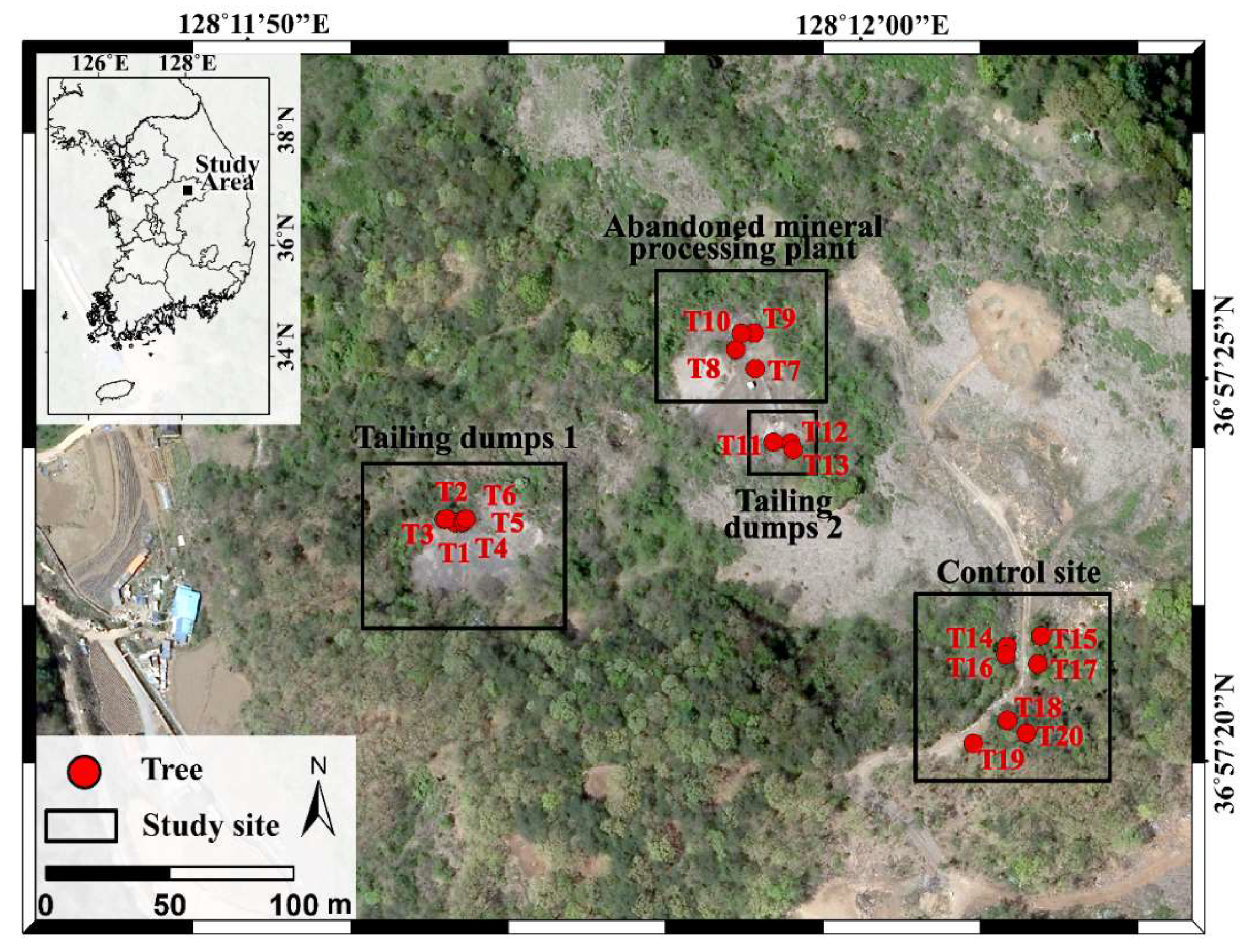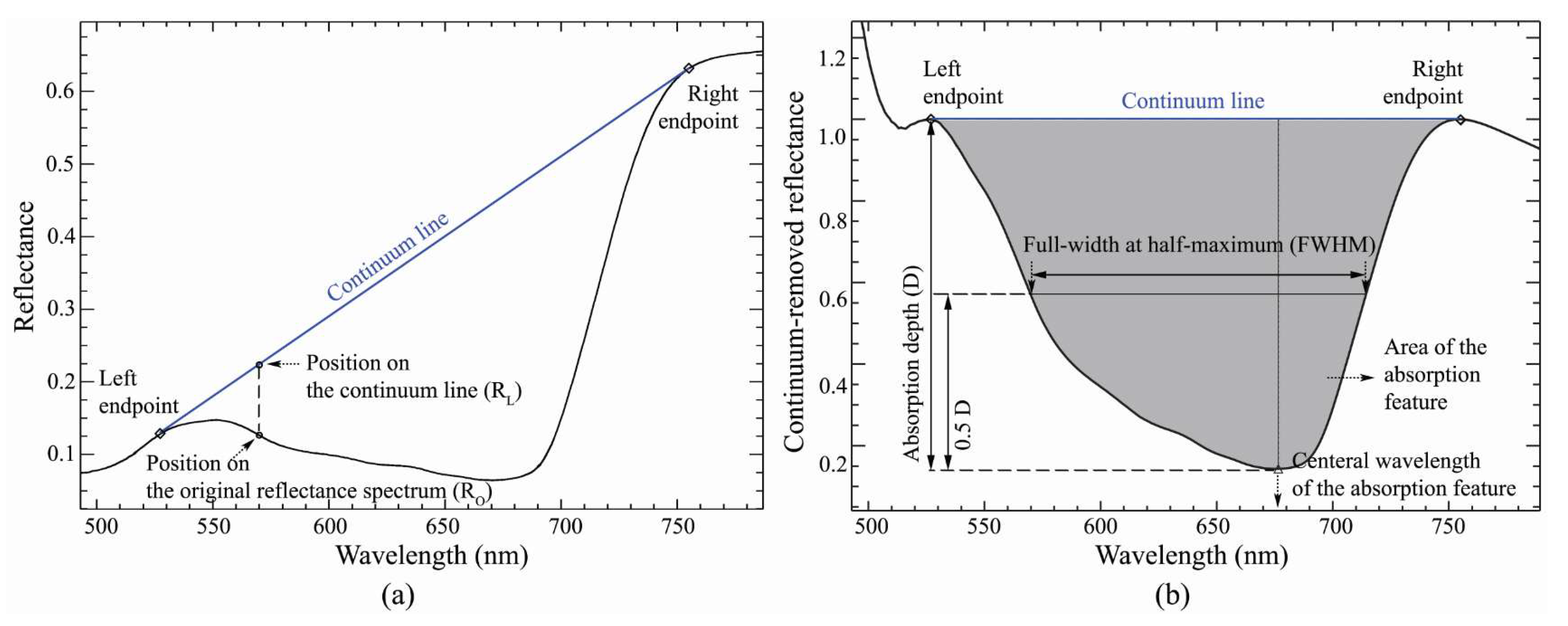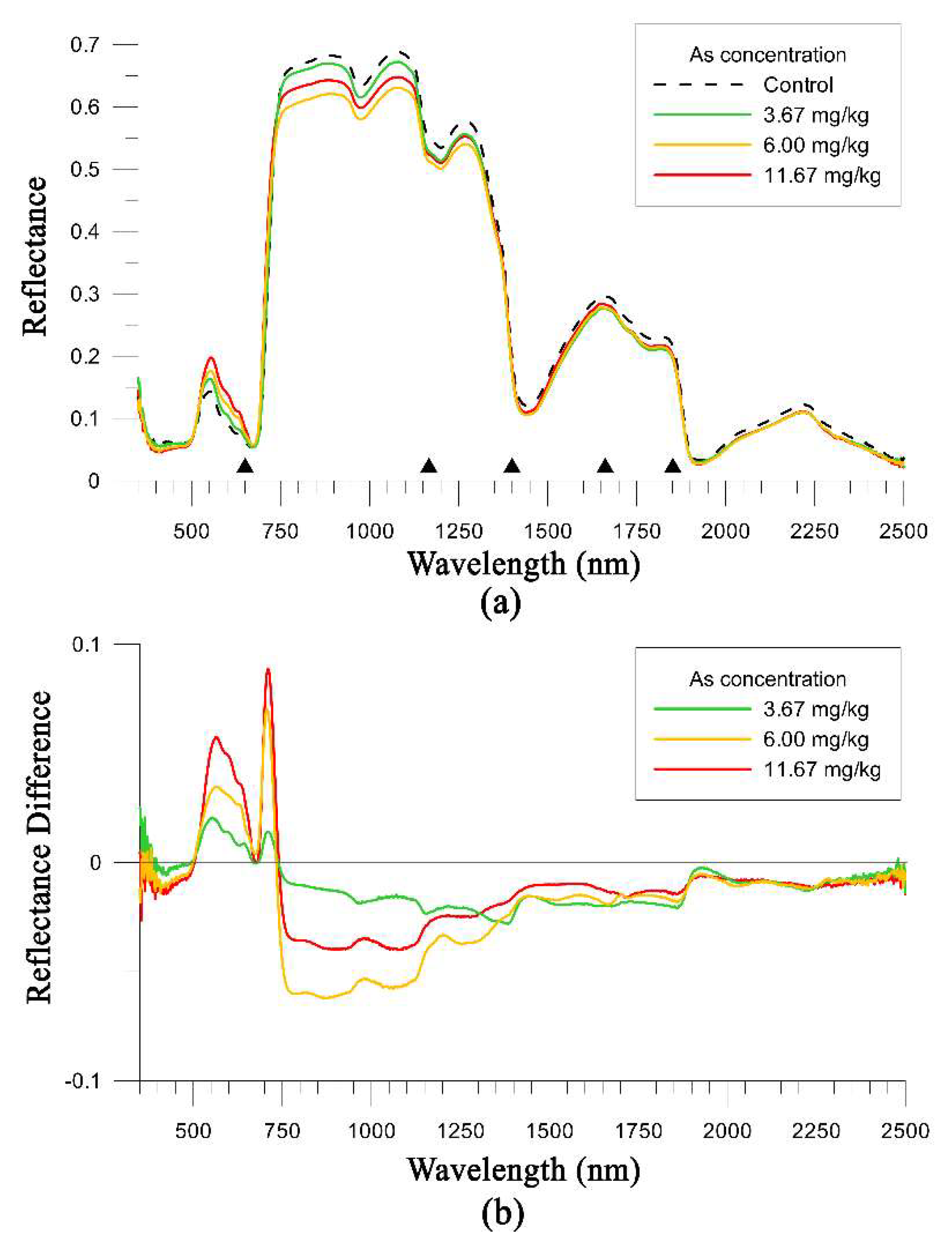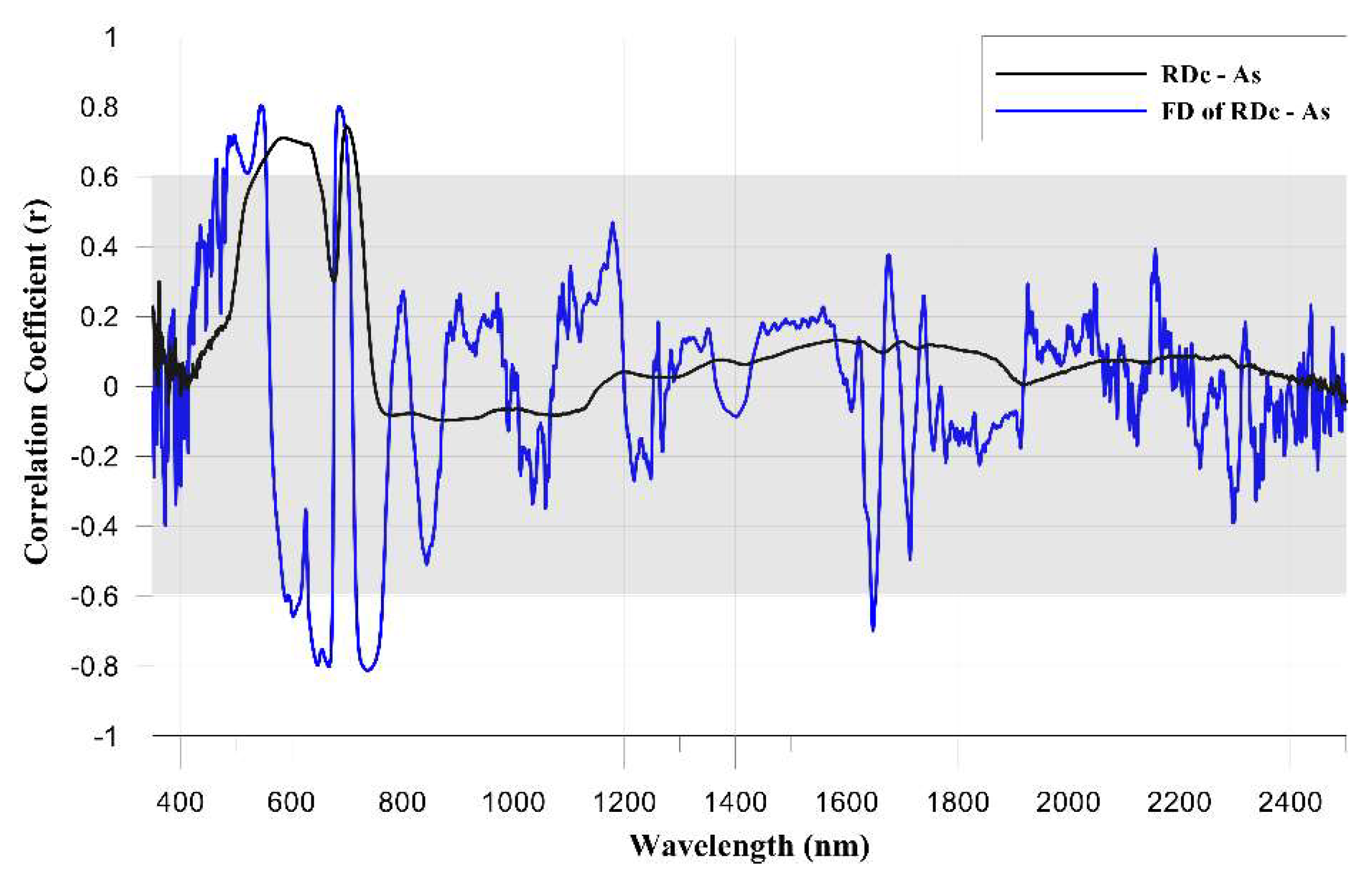Investigation of Spectral Variation of Pine Needles as an Indicator of Arsenic Content in Soils
Abstract
1. Introduction
2. Materials and Methods
2.1. Study Area
2.2. Site Selection and Sample Collection
2.3. PXRF Scanning
2.4. Spectral Analysis
2.5. Wavelength Selection and Regression Model Development
3. Results
3.1. Arsenic Content of Pine Needle Samples
3.2. Spectral Characteristics of Arsenic Contaminated Pine Needles
3.3. Wavelength Selection
3.4. Regression Model Development and Validation
4. Discussion
5. Conclusions
Author Contributions
Funding
Conflicts of Interest
References
- Alloway, B.J. Sources of heavy metals and metalloids in soils. In Heavy Metals in Soils: Trace Metals and Metalloids in Soils And their Bioavailability, 3rd ed.; Alloway, B.J., Ed.; Springer: Dordrecht, The Netherlands, 2013; pp. 11–50. [Google Scholar]
- Nagajyoti, P.C.; Lee, K.D.; Sreekanth, T.V.M. Heavy metals, occurrence and toxicity for plants: A review. Environ. Chem. Lett. 2010, 8, 199–216. [Google Scholar] [CrossRef]
- Li, X.; Liu, X.; Liu, M.; Wang, C.; Xia, X. A hyperspectral index sensitive to subtle changes in the canopy chlorophyll content under arsenic stress. Int. J. Appl. Earth. Obs. Geoinf. 2015, 36, 41–53. [Google Scholar] [CrossRef]
- Shi, T.; Liu, H.; Wang, J.; Chen, Y.; Fei, T.; Wu, G. Monitoring arsenic contamination in agricultural soils with reflectance spectroscopy of rice plants. Environ. Sci. Technol. 2014, 48, 6264–6272. [Google Scholar] [CrossRef] [PubMed]
- KME (Korean Ministry of Environment). Final Report of Environmental Investigation for Abandoned Mine in Korea, 2007; Ministry of Environment: Sejong, Korea, 2007.
- Schwartz, G.; Eshel, G.; Ben-Dor, E. Reflectance spectroscopy as a tool for monitoring contaminated soils. In Soil Contamination; InTech: London, UK, 2011. [Google Scholar]
- Dunagan, S.C.; Gilmore, M.S.; Varekamp, J.C. Effects of mercury on visible/near-infrared reflectance spectra of mustard spinach plants (Brassica rapa P.). Environ. Pollut. 2007, 148, 301–311. [Google Scholar] [CrossRef] [PubMed]
- Von Steiger, B.; Webster, R.; Schulin, R.; Lehmann, R. Mapping heavy metals in polluted soil by disjunctive kriging. Environ. Pollut. 1996, 94, 205–215. [Google Scholar] [CrossRef]
- Shi, T.; Liu, H.; Chen, Y.; Wang, J.; Wu, G. Estimation of arsenic in agricultural soils using hyperspectral vegetation indices of rice. J. Hazard. Mater. 2016, 308, 243–252. [Google Scholar] [CrossRef]
- Hernández, A.J.; Pastor Piñeiro, J. Validated approaches to restoring the health of ecosystems affected by soil pollution. In Soil Contamination Research Trend; Domínguez, J.D., Ed.; Nova Science Publishers: New York, NY, USA, 2008; pp. 51–72. [Google Scholar]
- Choe, E.; van der Meer, F.; van Ruitenbeek, F.; van der Werff, H.; de Smeth, B.; Kim, K.W. Mapping of heavy metal pollution in stream sediments using combined geochemistry, field spectroscopy, and hyperspectral remote sensing: A case study of the Rodalquilar mining area, SE Spain. Remote. Sens. Environ. 2008, 112, 3222–3233. [Google Scholar] [CrossRef]
- Kooistra, L.; Salas, E.A.L.; Clevers, J.G.P.W.; Wehrens, R.; Leuven, R.S.E.W.; Nienhuis, P.H.; Buydens, L.M.C. Exploring field vegetation reflectance as an indicator of soil contamination in river floodplains. Environ. Pollut. 2004, 127, 281–290. [Google Scholar] [CrossRef]
- Lamine, S.; Petropoulos, G.P.; Brewer, P.A.; Bachari, N.-E.-I.; Srivastava, P.K.; Manevski, K.; Kalaitzidis, C.; Macklin, M.G.J.S. Heavy Metal Soil Contamination Detection Using Combined Geochemistry and Field Spectroradiometry in the United Kingdom. Sensors 2019, 19, 762. [Google Scholar] [CrossRef]
- Dobrota, C.; Lazar, L.; Baciu, C. Assessment of physiological state of Betula pendula and Carpinus betulus through leaf reflectance measurements. Flora 2015, 216, 26–34. [Google Scholar] [CrossRef]
- Rosso, P.H.; Pushnik, J.C.; Lay, M.; Ustin, S.L. Reflectance properties and physiological responses of Salicornia virginica to heavy metal and petroleum contamination. Environ. Pollut. 2005, 137, 241–252. [Google Scholar] [CrossRef]
- Danson, F.M.; Steven, M.D.; Malthus, T.J.; Clark, J.A. High-spectral resolution data for determining leaf water content. Int. J. Remote Sens. 1992, 13, 461–470. [Google Scholar] [CrossRef]
- Datt, B. Remote sensing of chlorophyll a, chlorophyll b, chlorophyll a+b, and total carotenoid content in eucalyptus leaves. Remote Sens. Environ. 1998, 66, 111–121. [Google Scholar] [CrossRef]
- Féret, J.B.; François, C.; Gitelson, A.; Asner, G.P.; Barry, K.M.; Panigada, C.; Richardson, A.D.; Jacquemoud, S. Optimizing spectral indices and chemometric analysis of leaf chemical properties using radiative transfer modeling. Remote Sens. Environ. 2011, 115, 2742–2750. [Google Scholar] [CrossRef]
- Sridhar, B.B.M.; Han, F.X.; Diehl, S.V.; Monts, D.L.; Su, Y. Spectral reflectance and leaf internal structure changes of barley plants due to phytoextraction of zinc and cadmium. Int. J. Remote Sens. 2007, 28, 1041–1054. [Google Scholar] [CrossRef]
- Yost, E.; Wenderoth, S. The reflectance spectra of mineralized trees (Visible and near IR reflectance spectra of soil mineralized trees, using multispectral photographic filters). In Proceedings of the 7th International Symposium on Remote Sensing of Environment, University of Michigan, Ann Arbor, MI, USA, 17–21 May 1971; pp. 269–284. [Google Scholar]
- Collins, W.; Chang, S.H.; Raines, G.L.; Canney, F.; Ashley, R. Airborne biogeophysical mapping of hidden mineral deposits. Econ. Geol. 1983, 78, 737–749. [Google Scholar] [CrossRef]
- Kupková, L.; Potůčková, M.; Zachová, K.; Lhotáková, Z.; Kopačková, V.; Albrechtová, J. Chlorophyll Determination in silver birch and scots pine foliage from heavy metal polluted regions using spectral reflectance data. EARSeL E-Proc. 2012, 11, 64–73. [Google Scholar]
- Bandaru, V.; Hansen, D.J.; Codling, E.E.; Daughtry, C.S.; White-Hansen, S.; Green, C.E. Quantifying arsenic-induced morphological changes in spinach leaves: Implications for remote sensing. Int. J. Remote Sens. 2010, 31, 4163–4177. [Google Scholar] [CrossRef]
- Slonecker, T.; Haack, B.; Price, S. Spectroscopic analysis of arsenic uptake in Pteris ferns. Remote Sens. 2009, 1, 644–675. [Google Scholar] [CrossRef]
- Farjon, A. Pinus Densiflora. Available online: http://dx.doi.org/10.2305/IUCN.UK.2013-1.RLTS.T42355A2974820.en (accessed on 1 August 2018).
- Herawati, N.; Suzuki, S.; Hayashi, K.; Rivai, I.F.; Koyama, H. Cadmium, copper, and zinc levels in rice and soil of Japan, Indonesia, and China by soil type. Bull. Environ. Contam. Toxicol. 2000, 64, 33–39. [Google Scholar] [CrossRef]
- Liu, Y.; Li, W.; Wu, G.; Xu, X. Feasibility of estimating heavy metal contaminations in floodplain soils using laboratory-based hyperspectral data—A case study along Le’an River, China. Geo. Spat. Inf. Sci. 2011, 14, 10–16. [Google Scholar] [CrossRef]
- KMA (Korean Meteorological Administration). Annual Climatological Report; Korean Meteorological Administration: Seoul, Korea, 2017.
- Shin, J.H.; Yu, J.; Wang, L.; Kim, J.; Koh, S.-M.; Kim, S.-O. Spectral Responses of Heavy Metal Contaminated Soils in the Vicinity of a Hydrothermal Ore Deposit: A Case Study of Boksu Mine, South Korea. IEEE Trans. Geosci. Remote. Sens. 2019, 57, 4092–4106. [Google Scholar] [CrossRef]
- Liu, Y.; Chen, H.; Wu, G.; Wu, X. Feasibility of estimating heavy metal concentrations in Phragmites australis using laboratory-based hyperspectral data—A case study along Le’an River, China. Int. J. Appl. Earth. Obs. Geoinf. 2010, 12, S166–S170. [Google Scholar] [CrossRef]
- U.S. Environ. Protection Agency. Method 6200: Field Portable X-ray Fluorescence Spectrometry for the Determination of Elemental Concentrations in Soil and Sediment; U.S. Environ. Protection Agency: Washington, DC, USA, 2007. Available online: https://www.epa.gov/sites/production/files/2015-12/documents/6200.pdf (accessed on 22 August 2018).
- NIOSH. Method No. 7702: Lead by Field Portable XRF, 4th ed.; National Institute for Occupational Safety and Health (NIOSH): Cincinnati, OH, USA, 1998. Available online: https://www.cdc.gov/niosh/docs/2003-154/pdfs/7702.pdf (accessed on 1 August 2018).
- Hu, W.; Huang, B.; Weindorf, D.C.; Chen, Y. Metals analysis of agricultural soils via portable X-ray fluorescence spectrometry. Bull. Environ. Contam. Toxicol. 2014, 92, 420–426. [Google Scholar] [CrossRef]
- Melquiades, F.L.; Appoloni, C.R. Application of XRF and field portable XRF for environmental analysis. J. Radioanal. Nucl. Chem. 2004, 262, 533–541. [Google Scholar] [CrossRef]
- Sacristán, D.; Rossel, R.A.V.; Recatalá, L. Proximal sensing of Cu in soil and lettuce using portable X-ray fluorescence spectrometry. Geoderma 2016, 265, 6–11. [Google Scholar] [CrossRef]
- Weindorf, D.C.; Zhu, Y.; Chakraborty, S.; Bakr, N.; Huang, B. Use of portable X-ray fluorescence spectrometry for environmental quality assessment of peri-urban agriculture. Environ. Monit. Assess. 2012, 184, 217–227. [Google Scholar] [CrossRef]
- Weindorf, D.C.; Zhu, Y.; McDaniel, P.; Valerio, M.; Lynn, L.; Michaelson, G.; Clark, M.; Ping, C.L. Characterizing soils via portable x-ray fluorescence spectrometer: 2. Spodic and Albic horizons. Geoderma 2012, 189, 268–277. [Google Scholar] [CrossRef]
- Ulmanu, M.; Anger, I.; Gament, E.; Mihalache, M.; Plopeanu, G.; Ilie, L. Rapid determination of some heavy metals in soil using an X-ray fluorescence portable instrument. Res. J. Agric. Sci. 2011, 43, 235–241. [Google Scholar]
- Reidinger, S.; Ramsey, M.H.; Hartley, S.E. Rapid and accurate analyses of silicon and phosphorus in plants using a portable X-ray fluorescence spectrometer. New Phytol. 2012, 195, 699–706. [Google Scholar] [CrossRef]
- Kalnicky, D.J.; Singhvi, R. Field portable XRF analysis of environmental samples. J. Hazard. Mater. 2001, 83, 93–122. [Google Scholar] [CrossRef]
- Rautiainen, M.; Lukeš, P.; Homolova, L.; Hovi, A.; Pisek, J.; Mottus, M. Spectral properties of coniferous forests: A review of in situ and laboratory measurements. Remote Sens. 2018, 10, 207. [Google Scholar] [CrossRef]
- Daughtry, C.; Biehl, L.L. Changes in Spectral Properties of Detached Leaves; LARS Tech. Report 061584; Purdue University Laboratory for Applications of Remote Sensing: West Lafayette, IN, USA, 1984. [Google Scholar]
- Eitel, J.U.; Gessler, P.E.; Smith, A.M.; Robberecht, R. Suitability of existing and novel spectral indices to remotely detect water stress in Populus spp. For. Ecol. Manage. 2006, 229, 170–182. [Google Scholar] [CrossRef]
- Hong-Yan, R.E.N.; Zhuang, D.F.; Singh, A.N.; Jian-Jun, P.A.N.; Dong-Sheng, Q.I.U.; Run-He, S.H.I. Estimation of As and Cu contamination in agricultural soils around a mining area by reflectance spectroscopy: A case study. Pedosphere 2009, 19, 719–726. [Google Scholar] [CrossRef]
- Sanches, I.D.; Souza Filho, C.R.; Magalhães, L.A.; Quitério, G.C.M.; Alves, M.N.; Oliveira, W.J. Assessing the impact of hydrocarbon leakages on vegetation using reflectance spectroscopy. ISPRS J. Photogramm. Remote. Sens. 2013, 78, 85–101. [Google Scholar] [CrossRef]
- Kokaly, R.F.; Skidmore, A.K. Plant phenolics and absorption features in vegetation reflectance spectra near 1.66 μm. Int. J. Appl. Earth. Obs. Geoinf. 2015, 43, 55–83. [Google Scholar] [CrossRef]
- Savitzky, A.; Golay, M.J. Smoothing and differentiation of data by simplified least squares procedures. Anal. Chem. 1964, 36, 1627–1639. [Google Scholar] [CrossRef]
- Tsai, F.; Philpot, W. Derivative analysis of hyperspectral data. Remote Sens. Environ. 1998, 66, 41–51. [Google Scholar] [CrossRef]
- Kokaly, R.F. PRISM: Processing Routines in IDL for Spectroscopic Measurements (Installation Manual and User’s Guide, Version 1.0); Technical Report 2011-1155; US Geological Survey: Reston, VA, USA, 2011. [Google Scholar]
- Rathod, P.H.; Rossiter, D.G.; Noomen, M.F.; Van der Meer, F.D. Proximal spectral sensing to monitor phytoremediation of metal-contaminated soils. Int. J. Phytoremediat. 2013, 15, 405–426. [Google Scholar] [CrossRef]
- Wang, F.; Gao, J.; Zha, Y. Hyperspectral sensing of heavy metals in soil and vegetation: Feasibility and challenges. ISPRS J. Photogramm. Remote. Sens. 2018, 136, 73–84. [Google Scholar] [CrossRef]
- Yoder, B.J.; Pettigrew-Crosby, R.E. Predicting nitrogen and chlorophyll content and concentrations from reflectance spectra (400–2500 nm) at leaf and canopy scales. Remote Sens. Environ. 1995, 53, 199–211. [Google Scholar] [CrossRef]
- Chodak, M.; Niklińska, M.; Beese, F. Near-infrared spectroscopy for analysis of chemical and microbiological properties of forest soil organic horizons in a heavy-metal-polluted area. Biol. Fertil. Soils 2007, 44, 171–180. [Google Scholar] [CrossRef]
- Kemper, T.; Sommer, S. Estimate of heavy metal contamination in soils after a mining accident using reflectance spectroscopy. Environ. Sci. Technol. 2002, 36, 2742–2747. [Google Scholar] [CrossRef]
- Shi, T.; Cui, L.; Wang, J.; Fei, T.; Chen, Y.; Wu, G. Comparison of multivariate methods for estimating soil total nitrogen with visible/near-infrared spectroscopy. Plant. Soil 2013, 366, 363–375. [Google Scholar] [CrossRef]
- Vasques, G.M.; Grunwald, S.; Harris, W.G. Spectroscopic models of soil organic carbon in Florida, USA. J. Environ. Qual. 2010, 39, 923–934. [Google Scholar] [CrossRef]
- Chang, C.W.; Laird, D.A.; Mausbach, M.J.; Hurburgh, C.R. Near-infrared reflectance spectroscopy–principal components regression analyses of soil properties. Soil Sci. Soc. Am. J. 2001, 65, 480–490. [Google Scholar] [CrossRef]
- Kabata-Pendias, A.; Pendias, H. Trace Elements in Soil and Plants; CRC press: Boca Raton, FL, USA, 1984. [Google Scholar]
- Brackx, M.; Van Wittenberghe, S.; Verhelst, J.; Scheunders, P.; Samson, R. Hyperspectral leaf reflectance of Carpinus betulus L. saplings for urban air quality estimation. Environ. Pollut. 2017, 220, 159–167. [Google Scholar] [CrossRef]
- Carter, G.A.; Knapp, A.K. Leaf optical properties in higher plants: Linking spectral characteristics to stress and chlorophyll concentration. Am. J. Bot. 2001, 88, 677–684. [Google Scholar] [CrossRef]
- Kopačková, V.; Lhotáková, Z.; Oulehle, F.; Albrechtová, J. Assessing forest health via linking the geochemical properties of a soil profile with the biochemical parameters of vegetation. Int. J. Environ. Sci. Technol. 2015, 12, 1987–2002. [Google Scholar] [CrossRef]
- Kastori, R.; Plesničar, M.; Sakač, Z.; Panković, D.; Arsenijević-Maksimović, I. Effect of excess lead on sunflower growth and photosynthesis. J. Plant. Nutr. 1998, 21, 75–85. [Google Scholar] [CrossRef]
- Ma, J.F.; Yamaji, N.; Mitani, N.; Xu, X.-Y.; Su, Y.-H.; McGrath, S.P.; Zhao, F.-J. Transporters of arsenite in rice and their role in arsenic accumulation in rice grain. Proc. Natl. Acad. Sci. 2008, 105, 9931–9935. [Google Scholar] [CrossRef]
- Meharg, A.A.; Jardine, L. Arsenite transport into paddy rice (Oryza sativa) roots. New Phytol. 2003, 157, 39–44. [Google Scholar] [CrossRef]
- Zhao, F.J.; McGrath, S.P.; Meharg, A.A. Arsenic as a food chain contaminant: Mechanisms of plant uptake and metabolism and mitigation strategies. Annu. Rev. Plant. Biol. 2010, 61, 535–559. [Google Scholar] [CrossRef]
- Carter, G.A. Responses of leaf spectral reflectance to plant stress. Am. J. Bot. 1993, 80, 239–243. [Google Scholar] [CrossRef]
- Sabins, F.F. Remote sensing for mineral exploration. Ore. Geol. Rev. 1999, 14, 157–183. [Google Scholar] [CrossRef]
- Curran, P.J.; Dungan, J.L.; Gholz, H.L. Exploring the relationship between reflectance red edge and chlorophyll content in slash pine. Tree Physiol. 1990, 7, 33–48. [Google Scholar] [CrossRef]
- Foley, W.J.; McIlwee, A.; Lawler, I.; Aragones, L.; Woolnough, A.P.; Berding, N. Ecological applications of near infrared reflectance spectroscopy–a tool for rapid, cost-effective prediction of the composition of plant and animal tissues and aspects of animal performance. Oecologia 1998, 116, 293–305. [Google Scholar] [CrossRef]
- Aspinwall, M.J.; King, J.S.; Booker, F.L.; McKeand, S.E. Genetic effects on total phenolics, condensed tannins and non-structural carbohydrates in loblolly pine (Pinus taeda L.) needles. Tree Physiol. 2011, 31, 831–842. [Google Scholar] [CrossRef]
- Ushio, M.; Miki, T.; Kitayama, K. Phenolic control of plant nitrogen acquisition through the inhibition of soil microbial decomposition processes: A plant-microbe competition model. Microbes Environ. 2009, 24, 180–187. [Google Scholar] [CrossRef]
- Thenkabail, P.S.; Lyon, J.G.; Huete, A. Hyperspectral remote sensing of vegetation. In Advances in Hyperspectral Remote Sensing of Vegetation and Agricultural Croplands, 1st ed.; Thenkabail, P.S., Lyon, J.G., Huete, A., Eds.; CRC Press: Boca Raton, FL, USA, 2012; pp. 4–35. [Google Scholar]
- Sridhar, B.B.M.; Han, F.X.; Diehl, S.V.; Monts, D.L.; Su, Y. Monitoring the effects of arsenic and chromium accumulation in Chinese brake fern (Pteris vittata). Int. J. Remote Sens. 2007, 28, 1055–1067. [Google Scholar] [CrossRef]
- Sims, D.A.; Gamon, J.A. Relationships between leaf pigment content and spectral reflectance across a wide range of species, leaf structures and developmental stages. Remote Sens. Environ. 2002, 81, 337–354. [Google Scholar] [CrossRef]
- Wu, Y.; Chen, J.; Wu, X.; Tian, Q.; Ji, J.; Qin, Z. Possibilities of reflectance spectroscopy for the assessment of contaminant elements in suburban soils. Appl. Geochem. 2005, 20, 1051–1059. [Google Scholar] [CrossRef]
- Zhu, Y.; An, F.; Tan, J. Geochemistry of hydrothermal gold deposits: A review. Geosci. Front. 2011, 2, 367–374. [Google Scholar] [CrossRef]
- Yi, J.S.; Lee, J.M.; Chon, H.T. Chemical speciation of Arsenic in the water system from some abandoned Au-Ag mines in Korea. Econ. Environ. Geol. 2003, 36, 481–490. [Google Scholar]
- Kwon, J.C.; Park, H.J.; Jung, M.C. Correlation of Arsenic and Heavy Metals in Paddy Soils and Rice Crops around the Munmyung Au-Ag Mines. Econ. Environ. Geol. 2015, 48, 337–349. [Google Scholar] [CrossRef]





| Average Content | Soil Contamination Limits 1 | |||||
|---|---|---|---|---|---|---|
| Tailing Dump 1 | Abandoned Minerals Processing Plant | Tailing Dump 2 | Control Sites | Warning Limits | Counter-Plan Limits | |
| As | 16,420 | 24,530 | 11,600 | 50 | 50 | 150 |
| Pb | 27,500 | 8250 | 5690 | 80 | 400 | 1200 |
| Zn | 16,050 | 8110 | 5580 | 420 | 600 | 1800 |
| Cu | 3710 | 2130 | 1660 | 320 | 500 | 1500 |
| Cd | 190 | 180 | 50 | - | 10 | 30 |
| Statistics | Tailing Dump 1 | Abandoned Minerals Processing Plant | Tailing Dump 2 | Control | Total | ||||||||||
|---|---|---|---|---|---|---|---|---|---|---|---|---|---|---|---|
| T1 | T2 | T3 | T4 | T5 | T6 | T7 | T8 | T9 | T10 | T11 | T12 | T13 | T14-20 | ||
| No. of measurement | 7 | 10 | 8 | 2 | 4 | 19 | 14 | 29 | 23 | 19 | 19 | 6 | 3 | 23 | 186 |
| No. of detection | 2 | 0 | 1 | 0 | 0 | 2 | 10 | 23 | 21 | 17 | 16 | 0 | 0 | 0 | 92 |
| Mean | 1.5 | - | 2.0 | - | - | 2.7 | 5.5 | 3.0 | 7.3 | 4.1 | 2.3 | - | - | - | 3.5 |
| Min | 1.0 | - | 2.0 | - | - | 2.0 | 3.7 | 2.0 | 5.0 | 2.0 | 2.0 | - | - | - | 1.0 |
| Max | 2.0 | - | 2.0 | - | - | 3.3 | 7.0 | 4.7 | 11.7 | 8.0 | 3.0 | - | - | - | 11.7 |
| Wavelength Region (nm) | Strongest Correlation Spectrum (nm) | Strongest Correlation Coefficient |
|---|---|---|
| RDc | ||
| 535–648 | 586 | 0.71 |
| 690–719 | 700 | 0.74 |
| FD of RDc | ||
| 463–466 | 465 | 0.65 |
| 478 | 478 | 0.62 |
| 484–554 | 545 | 0.80 |
| 589–616 | 603 | –0.66 |
| 631–674 | 668 | –0.80 |
| 679–702 | 686 | 0.80 |
| 717–764 | 738 | –0.81 |
| 1645–1652 | 1648 | –0.70 |
| As Content | Left Endpoint | Right Endpoint | Central Feature Position | Feature Depth | Feature FWHM | Feature Area | |
|---|---|---|---|---|---|---|---|
| As content | 1.00 | 0.76 ** | −0.80 ** | 0.32 ** | −0.27 ** | −0.85 ** | −0.80 ** |
| Left endpoint | 1.00 | −0.83 ** | 0.38 ** | −0.13 | −0.85 ** | −0.76 ** | |
| Right endpoint | 1.00 | -0.24 * | 0.23 * | 0.92 ** | 0.85 ** | ||
| Central feature position | 1.00 | −0.30 ** | −0.37 ** | −0.43 ** | |||
| Feature depth | 1.00 | 0.36 ** | 0.61 ** | ||||
| Feature FWHM | 1.00 | 0.96 ** | |||||
| Feature area | 1.00 |
| Spectral Transformation | Spectral Parameter | Calibration | Validation | ||||
|---|---|---|---|---|---|---|---|
| R2C | RMSEC (mg/kg) | R2V | RMSEV (mg/kg) | SEP | RPD | ||
| Reflectance | 700 nm | 0.55 | 1.55 | 0.57 | 0.95 | 1.43 | 1.51 |
| First Derivative | 668 nm, 1648 nm | 0.74 | 1.18 | 0.79 | 0.84 | 0.98 | 2.19 |
| Absorption features | FWHM | 0.72 | 1.23 | 0.73 | 0.90 | 1.14 | 1.89 |
© 2019 by the authors. Licensee MDPI, Basel, Switzerland. This article is an open access article distributed under the terms and conditions of the Creative Commons Attribution (CC BY) license (http://creativecommons.org/licenses/by/4.0/).
Share and Cite
Shin, J.H.; Yu, J.; Wang, L.; Kim, J.; Koh, S.-M. Investigation of Spectral Variation of Pine Needles as an Indicator of Arsenic Content in Soils. Minerals 2019, 9, 498. https://doi.org/10.3390/min9080498
Shin JH, Yu J, Wang L, Kim J, Koh S-M. Investigation of Spectral Variation of Pine Needles as an Indicator of Arsenic Content in Soils. Minerals. 2019; 9(8):498. https://doi.org/10.3390/min9080498
Chicago/Turabian StyleShin, Ji Hye, Jaehyung Yu, Lei Wang, Jieun Kim, and Sang-Mo Koh. 2019. "Investigation of Spectral Variation of Pine Needles as an Indicator of Arsenic Content in Soils" Minerals 9, no. 8: 498. https://doi.org/10.3390/min9080498
APA StyleShin, J. H., Yu, J., Wang, L., Kim, J., & Koh, S.-M. (2019). Investigation of Spectral Variation of Pine Needles as an Indicator of Arsenic Content in Soils. Minerals, 9(8), 498. https://doi.org/10.3390/min9080498






